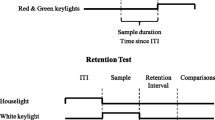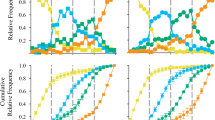Abstract
The ability to identify stimuli that signal important events is fundamental for an organism to adapt to its environment. In the present paper, we investigated how more than one stimulus could be used jointly to learn a temporal discrimination task. Ten pigeons were exposed to a symbolic matching-to-sample procedure with three durations as samples (2, 6, and 18 s of keylight) and two colors as comparisons (red and green hues). A 30-s intertrial interval (ITI), illuminated with a houselight, separated the trials. Both the houselight and the sample keylight could control responding, so two tests were run to assess how these stimuli influenced choice. In the no-sample test, the keylight was not presented; in the dark-ITI test, the houselight was not illuminated. Results suggest that both houselight and keylight controlled choice, and with the exception of one animal, the more a pigeon relied on one of these stimuli, the less it appeared to rely on the other.



Similar content being viewed by others
References
Blough DS (1969) Attention shifts in a maintained discrimination. Science 166:125–126
Chase S, Heinemann EG (1972) Choices based on redundant information: an analysis of two-dimensional stimulus control. J Exp Psychol 92:161–175
Cheng K, Spetch ML, Miceli P (1996) Averaging temporal duration and spatial position. J Exp Psychol Anim Behav Process 22:175–182
Church R (1980) Short-term memory for time intervals. Learn Motiv 11:208–219
Cohen J (1988) Statistical power analysis for the behavioral sciences. Lawrence Earlbaum Associates, Hillsdale
Gaitan S, Wixted J (2000) The role of “nothing” in memory for event duration in pigeons. Anim Learn Behav 28:147–161
Johnson D, Cumming W (1968) Some determiners of attention. J Exp Anal Behav 11:157–166
Kirkpatrick K, Church RM (2000) Stimulus and temporal cues in classical conditioning. J Exp Psychol Anim Behav Process 26:206–219
Kirkpatrick-Steger K, Wasserman EA (1996) The what and where of the pigeon’s processing of complex visual stimuli. J Exp Psychol Anim Behav Process 22:60–67
Kraemer PJ, Roberts WA (1985) Short-term memory for simultaneously presented visual and auditory signals in the pigeon. J Exp Psychol Anim Behav Process 11:137–152
Kraemer PJ, Mazmanian DS, Roberts WA (1987) Simultaneous processing of visual and spatial stimuli in pigeons. Anim Learn Behav 15:417–422
Lakens D (2013) Calculating and reporting effect sizes to facilitate cumulative science: a practical primer for t tests and ANOVAs. Frontiers Psychol 4:1–12
Leak TM, Gibbon J (1995) Simultaneous timing of multiple intervals: implications of the scalar property. J Exp Psychol Anim Behav Process 21:3–19
Leith CR, Maki WS (1975) Attention shifts during matching-to-sample performance in pigeons. Anim Learn Behav 3:85–89
Lovejoy E (1968) Attention in discrimination learning. Holden-Day, San Francisco
Mackintosh NJ (1965) Selective attention in animal discrimination learning. Psychol Bull 64:124–150
Mackintosh NJ (1975) A theory of attention: variations in the associability of stimuli with reinforcement. Psychol Rev 82:276–298
Maki WS, Leith CR (1973) Shared attention in pigeons. J Exp Anal Behav 16:345–349
McIlvane W, Dube W (2003) Stimulus control topography coherence theory: foundations and extensions. Behav Anal 26:195–213
Meck WH, Church RM (1983) A mode control model of counting and timing processes. J Exp Psychol Anim Behav Process 9:320–334
Meck WH, Church RM (1984) Simultaneous temporal processing. J Exp Psychol Anim Behav Process 10:1–29
Miles CG, Jenkins HM (1973) Overshadowing in operant conditioning as a function of discriminability. Learn Motiv 4:11–27
Pinto C, Machado A (2015) Coding in pigeons: multiple-coding versus single-code/default strategies. J Exp Anal Behav 103:472–483
Pinto C, Machado A (2017) Unraveling sources of stimulus control in a temporal discrimination task. Learn Behav 45:20–28
Reynolds G (1961) Attention in the pigeon. J Exp Anal Behav 4:203–208
Roberts WA, Mitchell S (1994) Can a pigeon simultaneously process temporal and numerical information? J Exp Psychol Anim Behav Process 20:66–78
Spetch M, Wilkie D (1983) Subjective shortening: a model of pigeons’ memory for event duration. J Exp Psychol Anim Behav Process 9:14–30
Sutherland NS, Mackintosh NJ (1971) Mechanisms of animal discrimination learning. Academic, San Diego
Sutton JE, Roberts WA (1998) Do pigeons show incidental timing? some experiments and a suggested hierarchical framework for the study of attention in animal cognition. Behav Process 44:263–275
Thomas DR (1970) Stimulus selection, attention, and related matters. In: Reynierse JH (ed) Current issues in animal learning. University of Nebraska Press, Lincoln, pp 311–356
Vieira de Castro AC, Machado A (2010) Prospective timing in pigeons: isolating temporal perception in the time-left procedure. Behav Process 84:490–499
Vyazovska OV, Teng Y, Wasserman EA (2014) Attentional tradeoffs in the pigeon. J Exp Anal Behav 101:337–354
Wagner AR, Logan FA, Haberlandt K, Price T (1968) Stimulus selection in animal discrimination learning. J Exp Psychol 76:171–180
Weiss SJ (1964) Summation of response strengths instrumentally conditioned along a composite-stimulus continuum during free-operant summation. J Exp Anal Behav 68:151–155
Wilkie DM, Masson ME (1976) Attention in the pigeon: a reevaluation. J Exp Anal Behav 26:207–212
Wolf MM (1963) Some effects of combined SDs. J Exp Anal Behav 6:343–347
Zeaman D, House BJ (1963) The role of attention in retardate discrimination learning. In: Ellis NR (ed) Handbook of mental deficiency: psychological theory and research. McGraw-Hill, New York, pp 159–223
Acknowledgements
The present work was conducted at the Psychology Research Centre, University of Minho, and was supported by the Portuguese Foundation for Science and Technology (FCT) and the Portuguese Ministry of Education and Science through national funds and when applicable co-financed by FEDER under the PT2020 Partnership Agreement (UID/PSI/01662/2013). This work was also supported by FCT Doctoral Grants to Carlos Pinto (SFRH/BD/78566/2011) and Inês Fortes (SFRH/BD/77061/2011), and a FCT Grant (PTDC/MHC-PCN/3540/2012) to Armando Machado.
Author information
Authors and Affiliations
Corresponding author
Ethics declarations
Conflict of interest
All authors declare that they have no conflict of interest.
Ethical approval
This research was conducted in agreement with European (Directive 2010/63/EU) and Portuguese law (Ordinance 1005/92 of October 23), and was approved by the Directorate-General for Food and Veterinary, the Portuguese national authority for animal health (Reference 0421/000/000/2013).
Rights and permissions
About this article
Cite this article
Pinto, C., Fortes, I. & Machado, A. Joint stimulus control in a temporal discrimination task. Anim Cogn 20, 1129–1136 (2017). https://doi.org/10.1007/s10071-017-1130-6
Received:
Revised:
Accepted:
Published:
Issue Date:
DOI: https://doi.org/10.1007/s10071-017-1130-6




